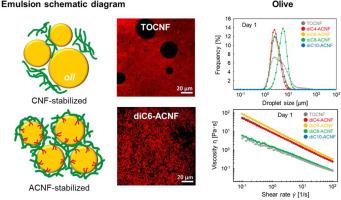使用烷基化纤维素纳米纤维增强皮克林乳液的稳定性和吸附性
IF 6.2
Q1 CHEMISTRY, APPLIED
Carbohydrate Polymer Technologies and Applications
Pub Date : 2024-09-25
DOI:10.1016/j.carpta.2024.100574
引用次数: 0
摘要
从植物细胞壁中提取的纤维素纳米纤维(CNFs)可在水中形成三维网络,稳定液滴的分散,可用作乳液稳定剂。本研究通过对 2,2,6,6-四甲基哌啶-1-氧自由基(TEMPO)氧化的 CNF(TOCNF)进行表面改性,合成了四种具有不同长度二烷基链(diC4、diC6、diC8 和 diC10)的烷基接枝 CNF(ACNF),以提高水包油型皮克林乳液(PE)的稳定性。使用两种不同的油(橄榄油和桉树油)和 ACNF 1.0 % 分散液制备了油水比为 20/80 的 ACNF 稳定乳液,并在约 25 °C 的温度下研究了其随时间的变化。与 TOCNF 相比,ACNF 提供了更稳定的橄榄油-聚乙烯(o-PE)和桉树油-聚乙烯(e-PE),尽管 o-PE 和 e-PE 的稳定行为有所不同。橄榄油含有丰富的长链脂肪酸,更容易与 ACNFs 发生相互作用,从而促进油滴的界面吸附。另一方面,桉树油的主要成分是 1,8-蒎烯,不含烷基链,因此与 ACNF 的相互作用较弱,无法获得充分的界面吸附。粒度分布和粘度测量的结果也表明,ACNFs 对邻丙醚的稳定作用很大。根据总体实验结果,我们确定 diC6-ACNF 对稳定性的改善最为显著。因此,我们设计了一种模仿 diC6-ACNF 的烷基化 CNF 进行 MD 模拟。MD 模拟结果表明,疏水改性在烷基链和作为油的十二烷分子之间产生了疏水相互作用,从而增强了 ACNF 在油滴界面的吸附性。本文章由计算机程序翻译,如有差异,请以英文原文为准。

Enhancing emulsion stability and adsorption of Pickering emulsions using alkylated cellulose nanofibers
Cellulose nanofibers (CNFs) extracted from plant cell walls form a three-dimensional network in water and stabilize the dispersion of droplets, which are used as emulsion stabilizers. In this study, four types of alkyl-grafted CNFs (ACNFs) with different lengths of dialkyl chains (diC4, diC6, diC8, and diC10) were synthesized by the surface modification of 2,2,6,6-tetramethylpiperidine-1-oxyl radical (TEMPO)-oxidized CNF (TOCNF) to improve the stability of oil-in-water Pickering emulsions (PEs). The ACNF-stabilized emulsions with a 20/80 ratio of oil/water were prepared using two different oils (olive oil and eucalyptus oil) and the ACNF 1.0 % dispersion, and the changes over time were investigated at approximately 25 °C. Compared to TOCNF, the ACNFs provided more stable olive oil-PE (o-PE) and eucalyptus oil-PE (e-PE) although the stabilization behaviors of o-PE and e-PE differed. Olive oil, which contained rich long-chain fatty acids, was more likely to interact with the ACNFs, thereby promoting the interfacial adsorption of oil droplets. On the other hand, eucalyptus oil is mainly composed of 1,8-cineole and does not have alkyl chains, so the interaction with the ACNFs was weak and therefore, sufficient interfacial adsorption could not be obtained. The results of the particle size distribution and viscosity measurements also showed that the ACNFs contributed significantly to the stabilization of o-PE. Based on the overall experimental results, it was determined that the diC6-ACNF gave the most significant stability improvement. Therefore, we designed an alkylated CNF that mimics diC6-ACNF for MD simulations. MD simulations showed that hydrophobic modification created a hydrophobic interaction between the alkyl chain and dodecane molecules as the oil, leading to the enhancing adsorption of ACNF at the oil droplet interfaces.
求助全文
通过发布文献求助,成功后即可免费获取论文全文。
去求助

 求助内容:
求助内容: 应助结果提醒方式:
应助结果提醒方式:


